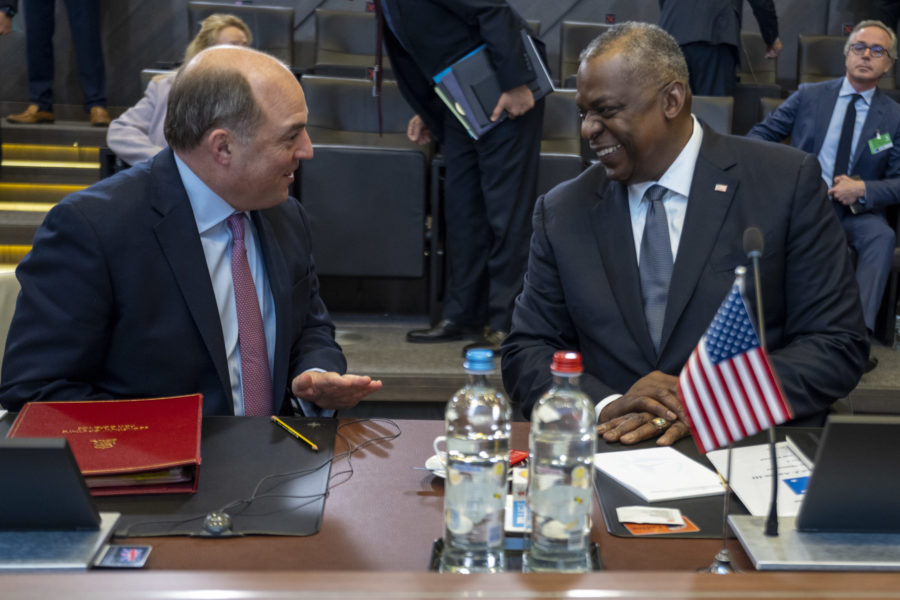Russia flew more than 300 sorties May 10, firing on targets in the Donbas region of Ukraine and the cities of Mariupol and Odesa as the war moved closer to Russian territory. Meanwhile, British defense minister Ben Wallace prepared to meet Defense Secretary Lloyd J. Austin III at the Pentagon.
Spring rain and mud in the trenches and flatlands of eastern Ukraine had yielded “slow and uneven” gains for Russia in its new eastern offensive in Ukraine, according to a senior defense official. But while artillery fired on the ground, Russia’s air strategy changed in recent days.
“The Russians’ [daily] sortie count is up over 300 now, so that is an increase from what we’ve seen in the past,” the official said, noting the uptick from the range of 200 to 300 in past weeks. “The air strikes are focused on the Donbas, Mariupol, and some standoff strikes on Odesa.”
The official said Russia is also conducting combat air patrols near Snake Island in the Black Sea, a tiny strategic feature some 20 miles off the coast of NATO ally Romania that Russia seized from Ukraine in the opening salvo of the conflict.
Ukraine reportedly fired on Russian positions on Snake Island on May 8, and Russia claims to have expelled an alleged attempt to retake the island. The U.S. has maintained a steady rotation of F-16s conducting NATO air policing from Romania’s Fetesti Air Base near the Black Sea coast, bolstering the effort of British and Italian typhoon jets operating from Mihail Kogălniceanu Air Base.
On April 29, six F-16s from the 510th Expeditionary Fighter Squadron at Aviano Air Base, Italy, arrived in Romania, replacing similar fighters from the 480th EFS, deployed from Spangdahlem Air Base, Germany.
The senior defense official briefing the media said that despite the Russian increase in sorties, the air space over Ukraine remained contested and Russian jets have largely stayed away from Ukrainian air space thanks to Ukraine’s effective air defenses.
The U.S. has provided more than 1,500 short-range air defense Stinger missiles and facilitated the transfer of hundreds more from the Baltics and elsewhere, while Slovakia transferred its S-300 long-range air defense system to Ukraine once it received assurances from NATO allies who temporarily transferred Patriot missile systems to protect Slovakia.
“We know it’s working because we continue to see the Russians weary of venturing into Ukrainian air space at all, and if they do, they don’t stay very long,” the official said.
“Most of their airstrikes are—almost all of them—were launched and recovered inside Russia, and they try to do these standoff strikes so that they don’t have to enter Ukrainian airspace,” the official said. “That speaks volumes as to how contested the air space is over there.”
Defense officials meeting at Ramstein Air Base, Germany, on April 26 as part of a 40-plus-nation Ukraine Contact Group told Air Force Magazine that air defenses were part of the discussion. Austin inaugurated the group to bolster defense aid to Ukraine. However, in recent weeks, battlefield changes have called for artillery, and nearly 90 American howitzers have since entered the fight.
The United States and United Kingdom have been key operators in rallying and channeling defense assistance to Ukraine. British Defense Minister Wallace will meet with Austin at the Pentagon on May 11.
“It goes without saying that Ukraine will be a major topic of discussion,” Pentagon Press Secretary John F. Kirby said in a May 10 press briefing. “The British have been leaders and strong, strong contributors in terms of providing security assistance to Ukraine, and in helping coordinate that assistance as well.”
Kirby added that the next monthly Ukraine Contact Group meeting will likely be held virtually at the end of May.
Congress is currently considering a $40 billion supplemental aid package to Ukraine that would keep a stream of weapons flowing for approximately five months, defense officials have said.
Drawn up at $33 billion, the House added an additional $7 billion in food and weapons, and a vote is expected the evening of May 10.
President Joe Biden has about $100 million left in presidential drawdown authority to turn over American weapon stocks to Ukraine. Strong congressional bipartisan support is expected to pass the new bill before defense assistance funding runs out.
